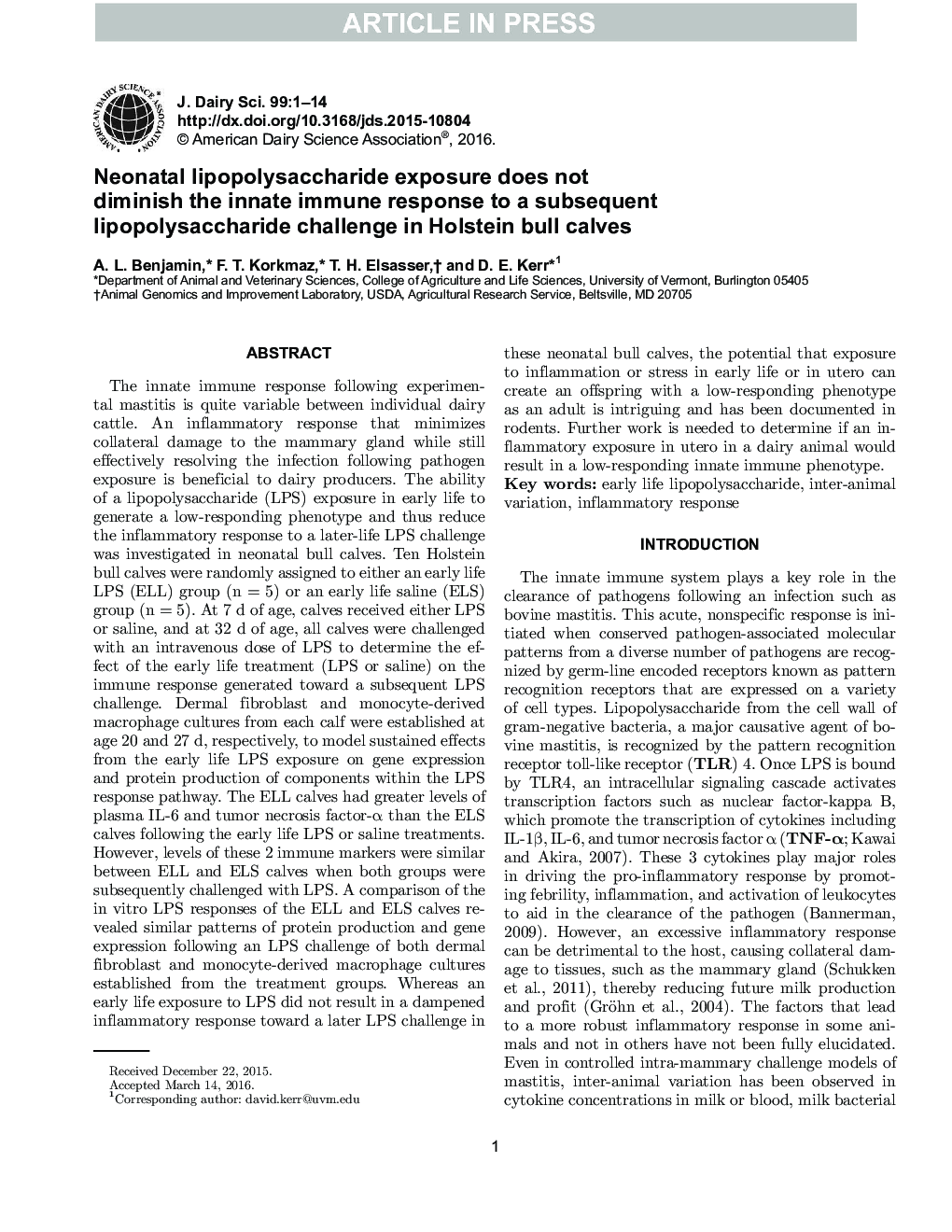| کد مقاله | کد نشریه | سال انتشار | مقاله انگلیسی | نسخه تمام متن |
|---|---|---|---|---|
| 10973672 | 1108017 | 2016 | 14 صفحه PDF | دانلود رایگان |
عنوان انگلیسی مقاله ISI
Neonatal lipopolysaccharide exposure does not diminish the innate immune response to a subsequent lipopolysaccharide challenge in Holstein bull calves
ترجمه فارسی عنوان
قرار گرفتن در معرض لیپوپلی ساکارید نوزادان واکنش ایمنی ذاتی را به چالش بعدی لیپوپلی ساکارید در گوساله های هولشتاین
دانلود مقاله + سفارش ترجمه
دانلود مقاله ISI انگلیسی
رایگان برای ایرانیان
کلمات کلیدی
زندگی اولیه لیپوپلی ساکارید، تنوع بین حیوانات، واکنش التهابی،
موضوعات مرتبط
علوم زیستی و بیوفناوری
علوم کشاورزی و بیولوژیک
علوم دامی و جانورشناسی
چکیده انگلیسی
The innate immune response following experimental mastitis is quite variable between individual dairy cattle. An inflammatory response that minimizes collateral damage to the mammary gland while still effectively resolving the infection following pathogen exposure is beneficial to dairy producers. The ability of a lipopolysaccharide (LPS) exposure in early life to generate a low-responding phenotype and thus reduce the inflammatory response to a later-life LPS challenge was investigated in neonatal bull calves. Ten Holstein bull calves were randomly assigned to either an early life LPS (ELL) group (n = 5) or an early life saline (ELS) group (n = 5). At 7 d of age, calves received either LPS or saline, and at 32 d of age, all calves were challenged with an intravenous dose of LPS to determine the effect of the early life treatment (LPS or saline) on the immune response generated toward a subsequent LPS challenge. Dermal fibroblast and monocyte-derived macrophage cultures from each calf were established at age 20 and 27 d, respectively, to model sustained effects from the early life LPS exposure on gene expression and protein production of components within the LPS response pathway. The ELL calves had greater levels of plasma IL-6 and tumor necrosis factor-α than the ELS calves following the early life LPS or saline treatments. However, levels of these 2 immune markers were similar between ELL and ELS calves when both groups were subsequently challenged with LPS. A comparison of the in vitro LPS responses of the ELL and ELS calves revealed similar patterns of protein production and gene expression following an LPS challenge of both dermal fibroblast and monocyte-derived macrophage cultures established from the treatment groups. Whereas an early life exposure to LPS did not result in a dampened inflammatory response toward a later LPS challenge in these neonatal bull calves, the potential that exposure to inflammation or stress in early life or in utero can create an offspring with a low-responding phenotype as an adult is intriguing and has been documented in rodents. Further work is needed to determine if an inflammatory exposure in utero in a dairy animal would result in a low-responding innate immune phenotype.
ناشر
Database: Elsevier - ScienceDirect (ساینس دایرکت)
Journal: Journal of Dairy Science - Volume 99, Issue 7, July 2016, Pages 5750-5763
Journal: Journal of Dairy Science - Volume 99, Issue 7, July 2016, Pages 5750-5763
نویسندگان
A.L. Benjamin, F.T. Korkmaz, T.H. Elsasser, D.E. Kerr,
